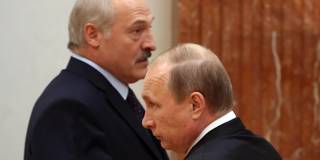After decades of maintaining a loveless geopolitical marriage, Belarusian President Aleksandr Lukashenko and Russian President Vladimir Putin are trying to figure out how each can use the other. But, with Lukashenko facing ongoing mass protests, the Kremlin clearly has much more to gain from a quid pro quo.
MOSCOW – Russian President Vladimir Putin’s public statements about the mass protests in Belarus have been at once forceful and ambiguous. For example, he says that a “law enforcement reserve” force has been prepared for potential engagement in Belarus. But that could mean personnel ranging from traffic cops and the police who break up demonstrations to the Federal Security Service (FSB, the main successor to the Soviet-era KGB) and heavily armed military units like the Rosgvardia (Russian Guard).
And what circumstances actually would prompt Russia to intervene? Putin says the “reserve” would “not be used until the situation starts getting out of control.” But who decides that? If it is up to Belarus’s beleaguered dictator, Aleksandr Lukashenko, Putin could say that the Kremlin will act only “at the request of the legally elected president of the republic.” That, after all, is how the Soviet Union framed its military interventions in Hungary in 1956 and Czechoslovakia in 1968.
But Putin has said nothing to this effect. In fact, his public statements suggest that he thinks he, not Lukashenko, should be in charge of the political process in Belarus. This has left Lukashenko hemmed in by a paradox: It would be better to risk being overthrown than to turn to Putin for military support.

MOSCOW – Russian President Vladimir Putin’s public statements about the mass protests in Belarus have been at once forceful and ambiguous. For example, he says that a “law enforcement reserve” force has been prepared for potential engagement in Belarus. But that could mean personnel ranging from traffic cops and the police who break up demonstrations to the Federal Security Service (FSB, the main successor to the Soviet-era KGB) and heavily armed military units like the Rosgvardia (Russian Guard).
And what circumstances actually would prompt Russia to intervene? Putin says the “reserve” would “not be used until the situation starts getting out of control.” But who decides that? If it is up to Belarus’s beleaguered dictator, Aleksandr Lukashenko, Putin could say that the Kremlin will act only “at the request of the legally elected president of the republic.” That, after all, is how the Soviet Union framed its military interventions in Hungary in 1956 and Czechoslovakia in 1968.
But Putin has said nothing to this effect. In fact, his public statements suggest that he thinks he, not Lukashenko, should be in charge of the political process in Belarus. This has left Lukashenko hemmed in by a paradox: It would be better to risk being overthrown than to turn to Putin for military support.